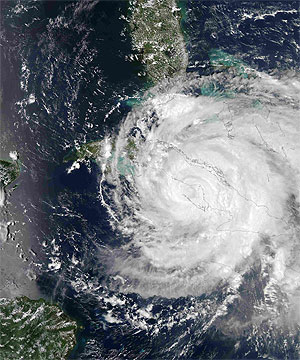Hurricane Ike entering the Gulf of Mexico in 2008. The storm is over Cuba and south of Florida.
NASA
Scientists Study Hurricanes of the Future
News story originally written on October 8, 2008
The Gulf of Mexico and Caribbean Sea are often in the path of hurricanes These violent storms are hazardous for people living near the coast. Often people need to evacuate during a storm to stay safe.
Recent hurricanes in this area, like Hurricanes Katrina and Rita, have had a big impact. And there’s evidence that global warming may cause more hurricanes, or that storms will get stronger. So it’s very important for scientists to learn more about how hurricanes might change because of global warming.
Scientists are now taking a close look at this area with weather and climate models. They are trying to figure out if changes in the number of hurricanes each year and changes in how powerful these storms are is likely to change over the next few decades. They also want to know whether climate change will affect the path of hurricanes and whether the powerful storms have an impact on global climate.
Last modified November 14, 2008 by Lisa Gardiner.
You might also be interested in:

Hurricanes form in the tropics over warm ocean water. The storms die down when they move over land or out of the tropics. At the center of the rotating storm is a small area of calm weather and clear skies
...more
Earth’s climate is getting warmer. During the past 100 years Earth’s average temperature rose about 0.6° Celsius (1.0° F). Things that people are doing like burning fossil fuels, changing the way land
...more
How do you know to pack your bathing suit and sunhat for a trip to a tropical island or pack warm sweaters and coats for a trip to Alaska? If you know a little about regional climates, then you know what
...more
Scientists have learned that Mount Hood, Oregon's tallest mountain, has erupted in the past due to the mixing of two different types of magma. Adam Kent, a geologist at Oregon State University, says this
...more
The Earth's mantle is a rocky, solid shell that is between the Earth's crust and the outer core. The mantle is made up of many different reservoirs that have different chemical compositions. Scientists
...more
Some faults look strong and like they wouldn’t cause an earthquake. But it turns out that they can slip and slide like weak faults causing earthquakes. Scientists have been looking at one of these faults
...more
The sun goes through cycles that last approximately 11 years. These solar cycle include phases with more magnetic activity, sunspots, and solar flares. They also include phases with less activity. The
...more















